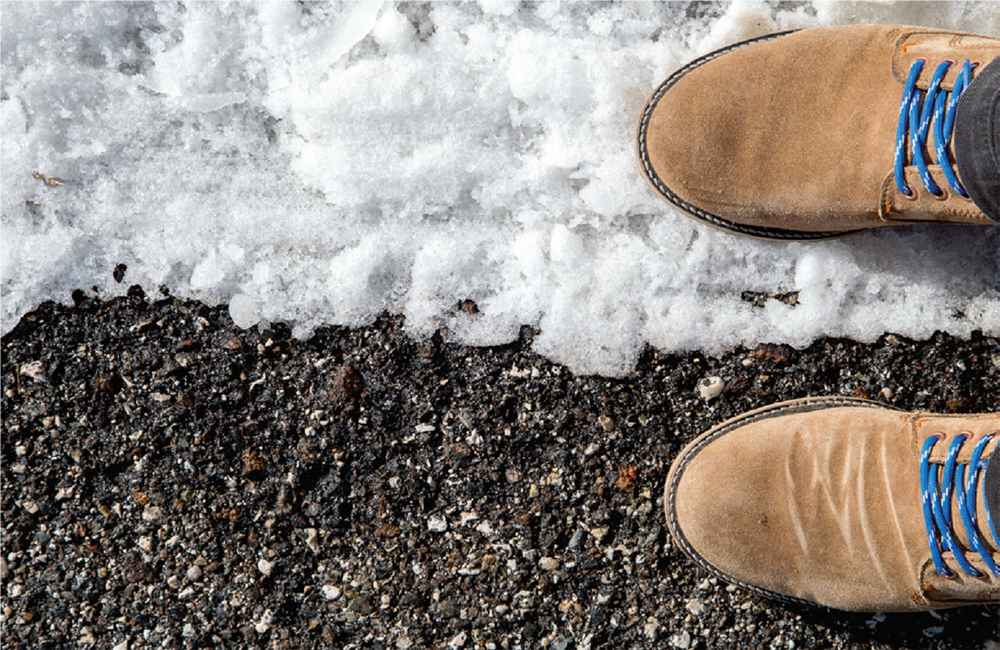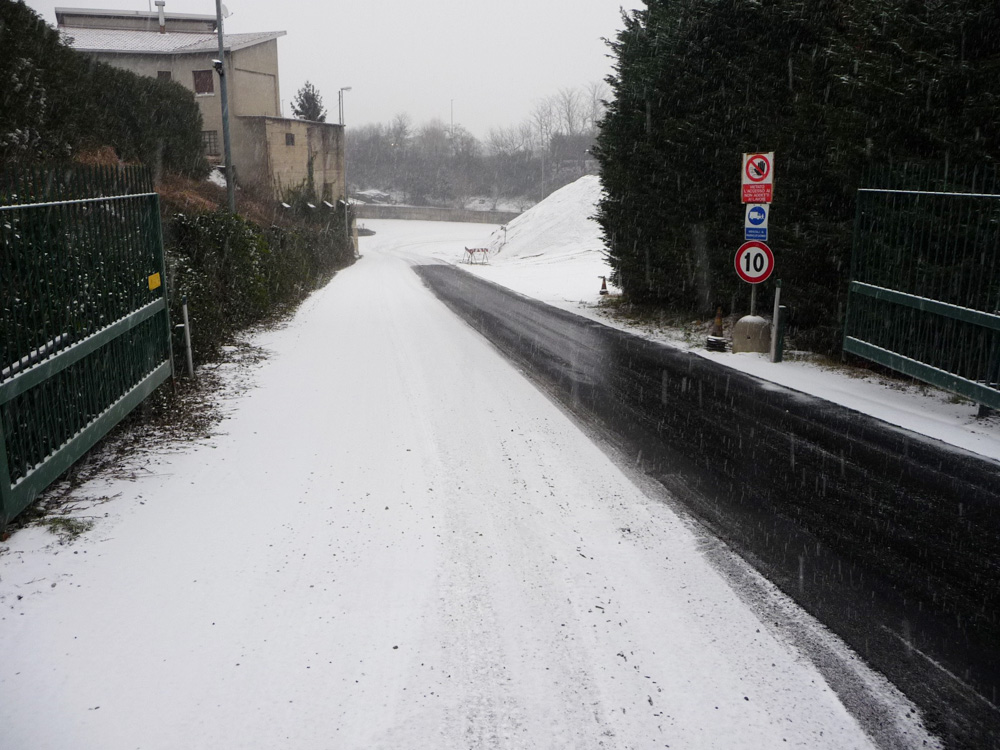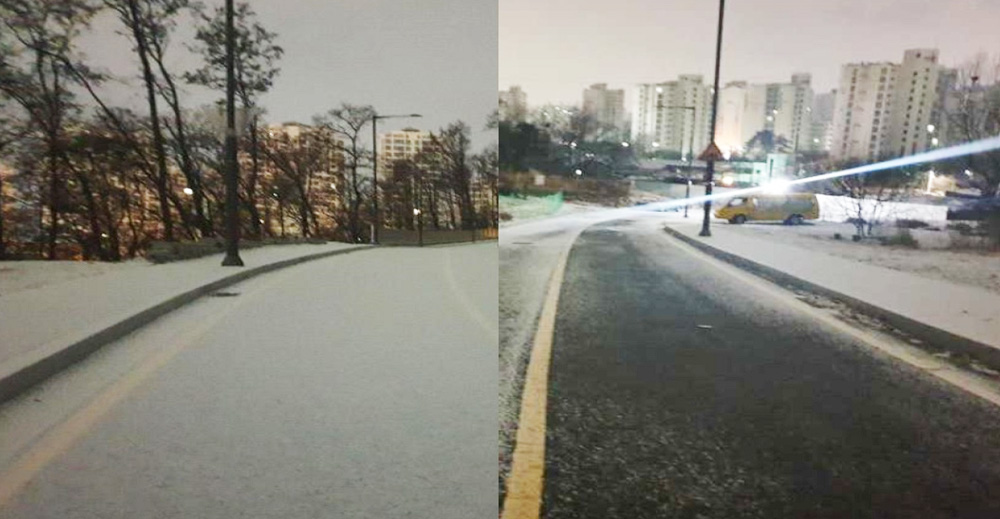
Winter maintenance operations of roads are crucial to ensure that a reasonable level of the safety of passengers is achieved. In particular, snow and ice can cause severe problems for high-speed roads and airports. The road authorities define de-icing strategies to be applied during the cold seasons. Generally speaking, de-icing is defined as the process of removing ice and snow by depressing the freezing point of water to fall below zero [1].
Accordingly, several routine practices are applied, including mechanical methods and liquid and solid de-icing agents. Mechanical methods involve the use of brushes, blowers and shovels to remove and to clean the surface of the road pavement from accumulation of snow or ice. Liquid agents and solid agents are generally different types of salts, which can be used depending on the type of the pavement and road. Comparing the solid and liquid de-icing materials, it can be noticed that the rock salt placed on the pavement surface can be removed by vehicle traffic.
For example, studies show that traffic from as few as five cars can knock off 80% of solid ice-melting material, such as sand or rock salt. In contrast, liquid ice-fighting materials penetrate the pores of road surfaces and therefore are not disturbed by vehicle traffic [2].
Sodium chloride NaCl (ordinary rock salt), CaCl2 calcium chloride, magnesium chloride, and acetates such as calcium magnesium acetate (CMA) or potassium acetate are some of the materials for road de-icing purposes [3]. However, the growing use of de-icers has raised concerns about their effects on motor vehicles, transportation infrastructure, and the environment. Generally, several disadvantages are attributed to both solid and liquid surface de-icing treatments. They have adverse effects on the environment, buildings, and plants while melting the snow. Chloride salt can cause a strong corrosive action on pavement structure [4&5].

The melting snow and ice carry de-icing chemicals onto vegetation and into soils along the roadside where they eventually enter local waterways. Elevated salt levels in soils can inhibit the ability of vegetation to absorb both water and nutrients, which can slow plant growth and ultimately affect animal habitats [6]. Related to environmental impacts, it has been shown that the salt used for de-icing may attract wildlife to roadways, increasing the likelihood of wildlife-vehicle collisions. In addition to the environmental impacts and damages of the pavement itself, the de-icing materials contribute to the corrosion of metals used in vehicles. All these impacts have been attested by several research works and field practices [7].
To this end, in addition to the traditional de-icing routines in recent years, other innovations such as self-de-icing asphalt pavements have shown promising results. The idea is to add de-icers to the asphalt mix during the production. This type of additive is a convenient solution for areas of high risk of accidents such as busy intersections, hilly streets or icy zones. By reducing the adherence between ice and road surface these pavements provide safer driving conditions alongside less winter maintenance costs. From another point of view, since this type of additive reduces the freezing point of the pavement, the number of the freeze/thaw cycles will be reduced, making the road less susceptible to damage and giving the road longer life. The present paper is a synthesis of the-state-of-the-practice of an anti-icing pavement additive.
An innovative anti-icing pavement additive
A de-icing additive for asphalt mixtures is available that avoids the issues of conventional products, however. The additive Winterpave is provided by Iterchimica in Italy. Winterpave lowers the freezing point of the water on the pavement. When the temperature drops and the snow falls, Winterpave prevents snow and ice from sticking to the road. It also interferes with the formation of ice crystals on the road surface and prevents their adhesion, which facilitates their removal. Consequently, it provides more time for the intervention of salt spreaders and snow-clearing equipment. Winterpave is mixed directly with asphalt during production and can be used by both batch and continuous asphalt plant. The mix design is formulated to replace 4-5% of the aggregate weight, usually replacing lower gradation materials, filler or sand. At a batch plant, Winterpave in low melt bags is added before bitumen. Similarly, in a continuous plant it must be added into the outer drum before the liquid binder. Once that Winterpae is added, the rest of the production procedure is the same, using traditional equipment. Winterpave is installed in the wearing course of the pavement.
Anti-icing asphalt mix design
Technically, the anti-icing asphalt mix design involves the replacing of some of the sand portion (4-5%) of the aggregates with de-icing additives. In most cases, the volumetric properties and the optimum bitumen content of the mixture would remain the same. The investigations show that the tensile properties, water sensitivity, Marshall stability and flow, which are the fundamental parameters of any asphalt mixture during performance mix design, also comply with most of the specifications’ requirements.
Test tracks and field investigations
Winterpave anti-icing additive has been trialled and used in many test tracks and paving projects. The additive has been applied successfully in different types of asphalt mixtures, including porous asphalt and SMA.
The performance of a Winterpave-containing asphalt pavement lane has been compared in trials the a lane to the same asphalt but without additive. The project took place in 2010 in Verano Brianza, Italy. It consisted of a 4.5cm dense-graded asphalt concrete containing 5% of the anti-icing additive. The pavement featuring Winterpave performed as intended during the snowfall.

South Korea installed a section of anti-icing asphalt pavement containing Winterpave in 2019. The section located in Dasan 2-dong, Namyangju, Gyeonggi-do consisted of a 100m-long trial compared with the same asphalt concrete but without the anti-icing additive.
Full monitoring of the trial sections was carried out in February 2020 at the temperature of below -3°C. While the reference mixture without additive was fully covered with snow, the section containing the additive was almost clear, highlighting the effectiveness of this technology.
In addition to the road paving applications, the technology has proved to be a very convenient solution for cycling paths. The first cycling path with anti-icing pavement was installed in 2015 in Naaldwijk, the Netherlands, where its performance is still being monitored during the low-temperature seasons. The four-year record shows the successful performance of the project so far.
Conclusions
Road pavement preservation of the cold-climate regions has always been a challenge for the road authorities. Nowadays, the traditional strategies including surface de-icing materials (either solid or liquid) are no longer considered a sustainable solution. Bearing in mind environmental harm and technical deficiencies of pavement damage, more sustainable solutions have been introduced recently. Self-de-icing additive for the construction of self-de-icing asphalt pavements is one of the promising solutions that have been introduced. This technology provides safer road surfaces by delaying the ice formation and, in many cases, reduces the anti-icing spreading frequency, that means less transportation under cold weather conditions.
References:
[1] P. Keikhaei Dehdezi & I. Widyatmoko, De-icing/Anti-icing agents and their effects on airfield asphalt pavements. Asphalt Professional, 2015, PP. 28-32. https://www.instituteofasphalt.org/
[2] Snow Magazine, available online 27.07.2020 https://www.snowmagazineonline.com/article/leap-to-liquids/
[3] Pavement interactive, Pavement Condition and Winter De-icing Treatments
[4] W.B. Yu, X. Yi, M. Guo, et al, State of the art and practice of pavement anti‐icing and de‐icing techniques. Sciences in Cold and Arid Regions, 2014, 6(1): 14–21. DOI: 10.3724/SP.J.1226.2014.00014.
[5] X. Shi, L. Fay, Z. Yang, T. A. Nguyen, and Y. Liu, Corrosion of de-icers to metals in transportation infrastructure: introduction and recent developments, Corros. Reviews, in press, 2009.
[6] The environmental literacy council, available online 27.07.2020: https://enviroliteracy.org/
[7] P. C. Casey, C. W. Alwan, C. F. Kline, G. K. Landgraf, K. R. Linsenmayer, impacts of using salt and salt brine for roadway deicing. Idaho Transportation Department Research Program, Available online 28/07/2020: https://www.ctcandassociates.com/work-samples/saltimpacts.pdf , 2014.










